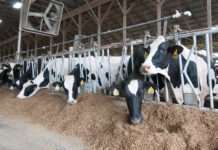Producers can assess the status of their wheat crop going into the winter in a few different ways. One important way is looking at the top-growth and counting leaves and tillers. As mentioned previously, wheat needs at least 4-5 leaves and 1-2 tillers prior to winter dormancy for maximum cold tolerance. Wheat that has fewer tillers and leaves will be more susceptible to winter kill.
It is important to also look at the root system development. Roots coming out from the seed are called seminal roots and are used to take up water and nutrients throughout the entire growing season. There are not very many of these roots so their contribution to overall water and nutrient uptake is limited. Crown roots are the two white protrusions coming out of the white area about an inch above the seed. These roots take up most of the water and nutrients needed by the plant, and they are very important for the plant to survive the winter. If a cow were grazing on this wheat, she would probably pull the plant out of the ground as there are not many roots holding the plant in the soil yet. Consequently, this wheat crop still needs considerable fall growth prior to grazing or winter dormancy.
Agriculture News
By: Ryan Flaming, Harvey County Extension Agent, Agriculture and Natural Resources




